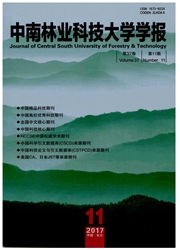

 中文摘要:
中文摘要:
研究森林生态系统碳储量以及碳汇功能是一项基础工作,对评价森林生态系统在碳平衡中的作用有着重要意义。对江西大岗山16年生杉木人工林生态系统碳储量和碳平衡进行研究,估算其碳汇/源功能。结果表昵杉木人工林生态系统总生物量为156.256t·hm^-2,乔木层占94.9%,林下层生物量为3.197t·hm^-2,年凋落物归还量为4.756t·hm^-2;杉木人工林碳储量为77.246t·hm^-2,其平均年净生产力为6.837t·hm^-2,其碳汇能力为1.595(±1.179)t·hm^-2a^-1,可见杉木人工林林生态系统显著地固定了大气中的CO2,有着明显的碳汇作用。
 英文摘要:
英文摘要:
The accurate research on carbon storage and carbon sinks function of forest ecosystems and is a basic works of ecology and plays a important role to appraise forest vegetation's action in carbon balance of ecosystems. The carbon storage and carbon balance of the 16-year-old Cunninghamia lanceolata plantation ecosystems in Dagangshan mountain, Jiangxi province were investigated based on the data collected from long-term located observation. The main results of the research are as followings: the biomass of Chinese fir forest was 156.256 t·hm^-2, that of tree layer accotmted for the 94.9% of total carbon storage, that of under-story biomass and annual litter amount were 3.197 t·hm^-2, 4.756 t·hm^-2, respectively; the total carbon storage was 77.246 t·hm^-2, which was the largest carbon pool, the mean net primary production was 6.837 t·hm^-2 according to annual tree ring width. The carbon sink function was 1.595 (±1.179) (t·hm^-2a^-1). It is significant that Chinese fir plantation was an effective approach to the fixed carbon. The capacity for forests to aid in climate change mitigation efforts is substantial, they can fttrther mitigate the increase in atmospheric CO2 that results from fossil fuel combustion and deforestation.
 同期刊论文项目
同期刊论文项目
 同项目期刊论文
同项目期刊论文
 期刊信息
期刊信息
